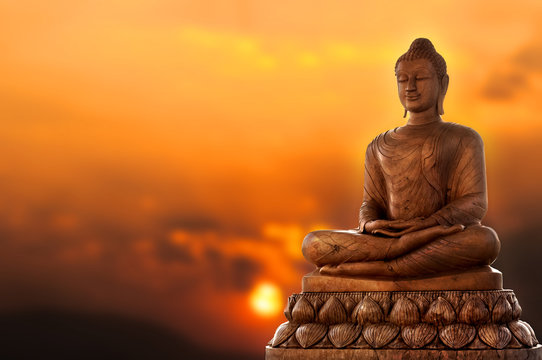Buddhism: The Path to Peace and Enlightenment

Introduction
Buddhism is one of the most peaceful and thoughtful religions in the world. It started more than 2,500 years ago in ancient India and has influenced millions of people around the world. Unlike many other religions, Buddhism does not focus on worshipping a god. Instead, it teaches how to live a good life, reduce suffering, and reach inner peace. This article will take you through the origin, history, founder, teachings, and followers of Buddhism in a simple and clear way.
The Origin of Buddhism
Buddhism began in the 6th century BCE in northern India, in a region near the Himalayas. It was founded by Siddhartha Gautama, who later became known as the Buddha, which means “The Enlightened One” or “The Awakened One.”
Siddhartha Gautama was born into a royal family in Lumbini, in present-day Nepal, around 563 BCE. His father was a king who wanted Siddhartha to become a great ruler. To protect him from the harsh realities of life, Siddhartha was raised in luxury and was not allowed to see sickness, old age, or death.
However, as a young man, Siddhartha went outside the palace and saw four sights that changed his life:
- An old man – He saw aging.
- A sick man – He saw illness.
- A dead body – He saw death.
- A holy man – A peaceful monk who had given up everything.
These experiences made him realize that suffering is a part of life. He decided to leave his royal life and go on a spiritual journey to find the truth about human suffering and how to overcome it.
Siddhartha’s Search for Truth
Siddhartha became a wandering seeker, practicing deep meditation and strict self-discipline. For several years, he tried extreme fasting and other difficult practices, but he did not find the answers he was looking for.
Finally, he sat under a Bodhi tree in Bodh Gaya, India, and meditated deeply. After 49 days of meditation, he achieved enlightenment. He understood the cause of suffering and how to end it. At that moment, Siddhartha became the Buddha.
From that time, he began teaching others what he had learned, which became the foundation of Buddhism.
Core Teachings of Buddhism
The Buddha’s teachings are known as the Dharma. They focus on understanding suffering, letting go of desires, and following a path to peace and wisdom.
The Four Noble Truths
At the heart of Buddhism are the Four Noble Truths:
- Life has suffering (Dukkha) – Everyone experiences pain, sadness, and dissatisfaction.
- There is a cause of suffering (Samudaya) – Suffering is caused by desire, greed, and attachment.
- There is an end to suffering (Nirodha) – If we let go of desire and attachment, we can end suffering.
- There is a path to end suffering (Magga) – This path is called the Eightfold Path.
The Eightfold Path
The Eightfold Path is a guide to live wisely, ethically, and mindfully. It includes:
- Right Understanding – Knowing the truth.
- Right Thought – Thinking kindly and wisely.
- Right Speech – Speaking truthfully and kindly.
- Right Action – Acting in a peaceful and honest way.
- Right Livelihood – Doing work that does not harm others.
- Right Effort – Trying to improve oneself.
- Right Mindfulness – Being aware of thoughts and actions.
- Right Concentration – Developing focus through meditation.
By following this path, one can achieve nirvana, a state of perfect peace and freedom from suffering and the cycle of rebirth.
https://sypertimes.com/chandratal-lake-the-moon-lake-of-the-himalayas/
Important Concepts in Buddhism
Karma
Karma means actions. Good actions lead to good results, and bad actions lead to suffering. It is the law of cause and effect.
Rebirth (Samsara)
Buddhists believe in a cycle of birth, death, and rebirth. This cycle continues until a person reaches enlightenment and breaks free.
Nirvana
Nirvana is the goal of Buddhism. It is the state of being free from suffering, desire, and the cycle of rebirth.
Compassion and Non-violence
Buddhism teaches kindness to all living beings and encourages non-violence (Ahimsa) in thoughts, words, and actions.

Spread of Buddhism
After the Buddha passed away at around the age of 80, his followers continued to spread his teachings.
Emperor Ashoka
One of the most important figures in spreading Buddhism was Emperor Ashoka of India. In the 3rd century BCE, Ashoka converted to Buddhism after witnessing the horrors of war. He built temples, sent missionaries, and spread Buddhist teachings to many countries, including Sri Lanka, Nepal, Afghanistan, and Southeast Asia.
Buddhism Around the World
- Sri Lanka and Southeast Asia: Theravāda Buddhism became the main form.
- China, Korea, and Japan: Mahāyāna Buddhism spread and developed new ideas.
- Tibet and Mongolia: Vajrayāna Buddhism became popular with unique rituals and practices.
Today, Buddhism is practiced in many countries across Asia, Europe, and the Americas.
Schools of Buddhism
Buddhism developed into different schools or branches, each with its own practices but all based on the Buddha’s teachings.
1. Theravāda Buddhism
- Means “The Way of the Elders.”
- Focuses on meditation, self-discipline, and the original teachings of the Buddha.
- Practiced in Sri Lanka, Thailand, Myanmar, Cambodia, and Laos.
2. Mahāyāna Buddhism
- Means “The Great Vehicle.”
- Includes the idea of Bodhisattvas – enlightened beings who help others.
- Practiced in China, Japan, Korea, and Vietnam.
3. Vajrayāna Buddhism
- Also called Tibetan Buddhism.
- Combines Mahayana teachings with mantras, rituals, and meditation.
- Practiced in Tibet, Bhutan, and Mongolia. The Dalai Lama is its most famous leader.
Sacred Texts and Symbols
Sacred Texts
- Tripitaka (Pāli Canon) – Oldest scriptures in Theravāda Buddhism.
- Sutras – Important texts in Mahāyāna Buddhism like the Lotus Sutra.
- Tibetan Canon – Includes special texts used in Vajrayāna Buddhism.
Symbols in Buddhism
- Dharma Wheel (Dharmachakra) – Represents the Eightfold Path.
- Lotus Flower – Symbolizes purity and spiritual awakening.
- Stupas – Dome-shaped buildings that hold relics of the Buddha.
- Bodhi Tree – The tree under which the Buddha attained enlightenment.

Buddhist Practices
Buddhists follow certain daily and spiritual practices to help them grow on the path:
- Meditation – Helps calm the mind and develop mindfulness.
- Chanting – Reciting sacred words or mantras.
- Pilgrimage – Visiting sacred sites like Lumbini, Bodh Gaya, Sarnath, and Kushinagar.
- Offerings – Giving food, flowers, or candles at temples.
- Observing the Five Precepts:
Followers of Buddhism Today
Buddhism has about 500 million followers worldwide. It is the main religion in countries like Thailand, Myanmar, Sri Lanka, Cambodia, Tibet, Bhutan, and Japan. In recent years, Buddhism has also become popular in Europe and North America, especially because of practices like mindfulness meditation.
Monks and Nuns
Many serious followers become monks or nuns. They live in monasteries, wear robes, shave their heads, and spend their time studying, meditating, and teaching others.
Buddhism in Modern Life
In today’s fast-moving world, many people find comfort in Buddhism’s teachings of peace, kindness, and awareness. Practices like mindfulness are widely used in schools, hospitals, and workplaces to help with stress and mental health.
Leaders like the Dalai Lama have also spread the message of compassion, tolerance, and human values around the world.
Conclusion
Buddhism is more than a religion. It is a way of life, a path to inner peace and wisdom. It teaches that true happiness doesn’t come from material things but from understanding ourselves and being kind to others. Starting from one man’s journey in ancient India, Buddhism has grown into a global tradition that continues to guide millions toward a life of peace, compass.




